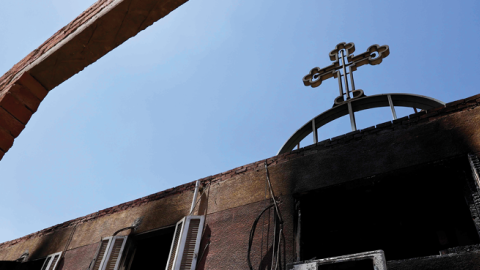On Sunday, August 14, a new tragedy befell Egypt’s Copts, a fire at Saint Marcurius Church in Imbaba has left forty-one dead, including eighteen children and the church’s priest. The fire is only the latest calamity to befall a community that is fighting for its survival.
Imbaba, originally a village and agricultural land, where Napoleon’s invading expedition had met and vanquished Egypt’s Mamluk forces in 1798, had slowly been absorbed into the capital as it expanded on both sides of the Nile, but the real population explosion began in the 1970s turning Imbaba into one of Giza’s (the Western half of Egypt’s Metropolitan Cairo) most overcrowded and poor neighborhoods in the city. Nasser’s regime had created a city for workers there but during the 1970s and 1980s new waves of immigrants coming mostly from the country’s south had overtaken them in numbers. It was a place ripe for the rise of Islamism and the militant’s campaign against the Egyptian regime found fertile ground there, culminating in the declaration of an Islamic Emirate there in the early 1990s, which forced the Mubarak regime into sending thousands of troops to the area and finally crushing the Islamist takeover.
Originally the area had few Copts, if any. Giza was not a governate with a strong Coptic presence and the whole governate had just one church until the 1940s, but the lure of the city began to attract Copts from the country’s south. Slowly Coptic families began settling in the area during the Nasserite period. The real uptick in Coptic settling in Imbaba, however, came in the 1990s. Gama’a Islamiya was waging a campaign against the Egyptian regime in the south of the country, where most Copts had historically dwelled, and Copts were often targeted in violent attacks that left tens of them dead. Even without the attacks, life became unbearable for those Copts, as Gama'a Islamiya enforced its radical views on the Copts forcing them to pay Jizya. Many Coptic families simply carried their bags and made their way to the capital and settled in Imbaba.
The Coptic population growth in the area required more churches and services and the Coptic Church obliged. In 1924, Giza, together with its northern neighbor, Qalioubia, received its own Bishop for the first time after being separated from Fayyoum and by 1963, the rising Coptic numbers required the church to divide them further with Giza receiving its own Bishop. The process would continue further in the 21st century with Giza divided into five dioceses in 2013, with Imbaba now having its own Bishop. But if the Coptic Church could adjust its administrative structure to meet the changing demographics, it could not as easily build churches to service those Copts, for standing in its way was the Egyptian regime’s draconian measures regarding church building permits.
Since 1938, the Egyptian regime had controlled the building of churches in the country through a set of laws and regulations that after a long process required the personal approval of Egypt’s ruler for not just every new church building but even renovations building bathrooms, or even repainting of old churches. During Mubarak’s thierty-year rule, Copts were lucky if they received ten new permits per year for both new churches and renovations. Even when all the paperwork was in order, it was a common practice for a mosque to suddenly appear next door in order to foil the church from gaining approval (the law prohibited the building of houses of worship next to each other, though that was only applied when a Church sought approval). In a nearby part of Giza, a Coptic church is known not by the name of the Saint it carries, but simply as the church of the seven mosques, due to the fact that Copts had to relocate it eight times before they finally could build it, since a mosque would appear next to the land they had bought for seven times.
Faced with this grim reality, Copts resorted to the only way possible for them to have places of worship; they built churches illegally. Some looked like churches. Others, like Saint Macarius, which was built in 2007, and where the recent fire took place, were simply multi story buildings that had a church on one of its floors while the others were filled with daycare facilities, classrooms for Sunday school, and maybe even a clinic to serve the needs of poor Copts. The buildings never had any safety measures and would never get any zoning approval from any regulatory authority, but they were the only option Copts had.
The Egyptian revolution brought new pain to Imbaba’s Copts. In May 2011, Salafis began gathering in front of Saint Mina Church in Imbaba demanding the release of a Christian women they claimed had converted to Islam and was held by the Church. The police searched the church and found no woman, but it did not matter. The mob attacked with gunfire and Molotov cocktails, leaving fifteen Copts dead, three churches burnt and shops and homes belonging to Copts burnt and ransacked. On the 14th of August 2013, and as news of the army’s massacre of Muslim Brotherhood supporters in Raba’a spread, Islamists attacked and destroyed more than 100 churches and church affiliated building across the country in what was the largest single attack on Copts since the 14th century. The Virgin Mary’s Church in Imbaba was one of those burnt.
Today’s tragedy only adds to Imbaba Copts’ pain. It is a pain shared by every Copt in Egypt and around the world. Every Copt seems to have a connection to Copts there, or if not, can fully relate to it, for their story is his story. Discrimination and persecution have formed a collective identity amongst Copts and the church fire has left Copts angry and in search for answers. While the official cause of the fire has so far been attributed to an electrical malfunction, many Copts on social media have pointed out that today marks the eighth anniversary of the Raba’a massacre and hence could be the work of Islamists who have continuously targeted Copts. Reinforcing those speculations is the fact that another Giza church had a minor fire the next day and on August 16th another church in Menya was burned to the ground. But in a sense, the immediate cause of the fire is irrelevant. The reality is that the fire and deaths is the perfect illustration not just of the Coptic tragedy but of Egypt’s as a whole.
One could start with the fact that firefighters arrived according to eyewitnesses an hour and a half late, despite their station being close by and blame their slow response for the deaths, but the reality is that firefighters in Egypt have very little equipment or training to deal with such events. While other government employees depend on bribes for the majority of their income, there is little bribery possible for firefighters resulting in them being amongst the worst paid jobs. Or one could blame a state that has failed to plan roads accessible for firefighters and failed to enforce any safety regulations, but the grim reality is that the state has very limited capacity here. The population explosion and the lack of adequate housing and services has meant that Cairo has grown into a city of hundreds of illegal neighborhoods where no building has the correct permits. One could point his finger to the Coptic Church for maintaining such a church building without any safety measures, and for having a daycare facility in the building, or for the lack of training for emergencies, but to do so, one would have to be blind to the reality that Copts live under in Egypt. No one can be solely blamed for the tragedy; the entire country is to blame.
The grim reality is that the collapse of Egypt’s fortunes since 1952 has been mirrored amongst its Copts. The country that once led the Middle East in modernization is today dependent on foreign handouts for its survival. The Cairo of literary giants and glamorous movies that were read and watched by every Arabic speaker in the Middle East hardly produces anything of cultural significance today. It is a country from which over a million Copts have migrated pursuing economic opportunities and religious freedom in the West. Or perhaps it is the reverse. A country that has been kicking out its minorities from the Jews, Italians and Greeks in the 1950s to the Copts today is simply bound to decline and to meet repeated tragedy.



















